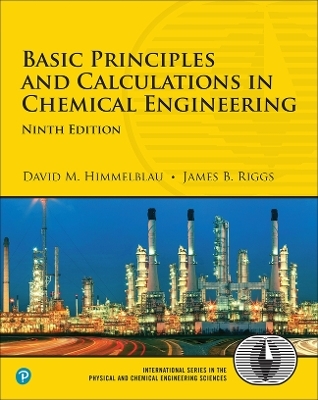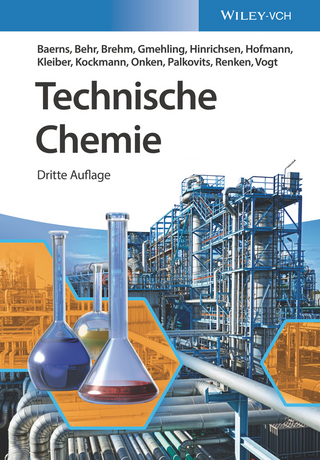
Basic Principles and Calculations in Chemical Engineering
Pearson (Verlag)
978-0-13-732717-1 (ISBN)
Basic Principles and Calculations in Chemical Engineering, Ninth Edition, has been thoroughly revised, streamlined, and updated to reflect sweeping changes in the chemical engineering field. This introductory guide addresses the full scope of contemporary chemical, petroleum, and environmental engineering applications and contains extensive new coverage and examples related to biotech, nanotech, green/environmental engineering, and process safety, with many new MATLAB and Python problems throughout.
Authors David M. Himmelblau and James B. Riggs offer a strong foundation of skills and knowledge for successful study and practice, guiding students through formulating and solving material and energy balance problems, as well as describing gases, liquids, and vapors. Throughout, they introduce efficient, consistent, learner-friendly ways to solve problems, analyze data, and gain a conceptual, application-based understanding of modern processes.
This edition condenses coverage from previous editions to serve today's students and faculty more efficiently. In two entirely new chapters, the authors provide a comprehensive introduction to dynamic material and energy balances, as well as psychrometric charts.
Modular chapters designed to support introductory courses of any length
Introductions to unit conversions, basis selection, and process measurements
Strategies for solving diverse material and energy balance problems, including material balances with chemical reaction and for multi-unit processes, and energy balances with reaction
Clear introductions to key concepts ranging from stoichiometry to enthalpy
Coverage of ideal/real gases, multi-phase equilibria, unsteady-state material, humidity (psychrometric) charts, and more
Self-assessment questions to help readers identify areas they don't fully understand
Thought, discussion, and homework problems in every chapter
New biotech, bioengineering, nanotechnology, green/environmental engineering, and process safety coverage
Relevant new MATLAB and Python homework problems and projects
Extensive tables, charts, and glossaries in each chapter
Reference appendices presenting atomic weights and numbers, Pitzer Z^0/Z^1 factors, heats of formation and combustion, and more
Easier than ever to use, this book is the definitive practical introduction for students, license candidates, practicing engineers, and scientists.
Supplemental Online Content (available with book registration):
Three additional chapters on Heats of Solution and Mixing, Liquids and Gases in Equilibrium with Solids, and Solving Material and Energy Balances with Process Simulators (Flowsheeting Codes)
Nine additional appendices: Physical Properties of Various Organic and Inorganic Substances, Heat Capacity Equations, Vapor Pressures, Heats of Solution and Dilution, Enthalpy-Concentration Data, Thermodynamic Charts, Physical Properties of Petroleum Fractions, Solution of Sets of Equations, Fitting Functions to Data
Register your book for convenient access to downloads, updates, and/or corrections as they become available. See inside book for details.
David M. Himmelblau was Paul D. and Betty Robertson Meek and American Petrofina Foundation Centennial Professor Emeritus in Chemical Engineering at the University of Texas, where he taught for forty-two years. He authored eleven books and more than two hundred articles on process analysis, fault detection, and optimization. He was president of the CACHE Corporation, and director of AIChE. James B. Riggs was a university professor for thirty years. Twenty-five of those years were spent at Texas Tech University, where he founded and directed the Texas Tech Process Control and Optimization Consortium. He authored several popular textbooks, including Computational Methods for Engineers with MATLAB Applications, Thirteenth Edition; Programming with MATLAB for Engineers, Fourteenth Edition; and Chemical and Bio-Process Control, Fifth Edition.
Preface xv
How to Use This Book xvii
Acknowledgments xxi
About the Authors xxiii
Part I: Introduction 1
Chapter 1: Introduction to Chemical Engineering 3
1.1 A Brief History of Chemical Engineering 3
1.2 Types of Jobs Chemical Engineers Perform 6
1.3 Industries in Which Chemical Engineers Work 8
1.4 Sustainability 10
1.5 Ethics 24
Chapter 2: Introductory Concepts 29
2.1 Units of Measure 29
2.2 Unit Conversions 35
2.3 Equations and Units 41
2.4 Measurement Errors and Significant Figures 47
2.5 Validation of Results 53
2.6 Mass, Moles, and Density 55
2.7 Process Variables 75
Part II: Material Balances 125
Chapter 3: Material Balances 127
3.1 The Connection between a Process and Its Schematic 129
3.2 Introduction to Material Balances 134
3.3 A General Strategy for Solving Material Balance Problems 145
3.4 Material Balances for Single Unit Systems 164
3.5 Vectors and Matrices 188
3.6 Solving Systems of Linear Equations with MATLAB 190
3.7 Solving Systems of Linear Equations with Python 196
Chapter 4: Material Balances with Chemical Reaction 225
4.1 Stoichiometry 226
4.2 Terminology for Reaction Systems 235
4.3 Species Mole Balances 248
4.4 Element Material Balances 268
4.5 Material Balances for Combustion Systems 276
Chapter 5: Material Balances for Multiunit Processes 313
5.1 Preliminary Concepts 314
5.2 Sequential Multiunit Systems 317
5.3 Recycle Systems 340
5.4 Bypass and Purge 357
5.5 The Industrial Application of Material Balances 367
Part III: Gases, Vapors, and Liquids 401
Chapter 6: Ideal and Real Gases 403
6.1 Ideal Gases 405
6.2 Real Gases: Equations of State 422
6.3 Real Gases: Compressibility Charts 436
6.4 Real Gas Mixtures 444
Chapter 7: Multiphase Equilibrium 473
7.1 Introduction 473
7.2 Phase Diagrams and the Phase Rule 475
7.3 Single-Component Two-Phase Systems (Vapor Pressure) 487
7.4 Two-Component Gas/Single-Component Liquid Systems 504
7.5 Two-Component Gas/Two-Component Liquid Systems 523
7.6 Multicomponent Vapor-Liquid Equilibrium 536
Part IV: Energy Balances 559
Chapter 8: Energy Balances without Reaction 561
8.1 Terminology Associated with Energy Balances 564
8.2 Overview of Types of Energy and Energy Balances 569
8.3 Energy Balances for Closed, Unsteady-State Systems 574
8.4 Energy Balances for Open, Steady-State Systems 597
8.5 Mechanical Energy Balances 627
8.6 Energy Balances for Special Cases 640
Chapter 9: Energy Balances with Reaction 681
9.1 The Standard Heat (Enthalpy) of Formation 682
9.2 The Heat (Enthalpy) of Reaction 688
9.3 Integration of Heat of Formation and Sensible Heat 700
9.4 The Heat (Enthalpy) of Combustion 726
Part V: Combined Material and Energy Balances 747
Chapter 10: Humidity (Psychrometric) Charts 749
10.1 Terminology 751
10.2 The Humidity (Psychrometric) Chart 755
10.3 Applications of the Humidity Chart 765
Chapter 11: Unsteady-State Material and Energy Balances 781
11.1 Unsteady-State Balances 783
11.2 Numerical Integration of ODEs 790
11.3 Examples 799
Supplemental online materials:
Chapter 12: Heats of Solution and Mixing 825
Chapter 13: Liquids and Gases in Equilibrium with Solids 845
Chapter 14: Solving Material and Energy Balances Using Process Simulators (Flowsheeting Codes) 857
Part VI: Supplementary Material--Appendixes 889
Appendix A: Atomic Weights and Numbers 893
Appendix B: Tables of the Pitzer Z^0 and Z^1 Factors 894
Appendix C: Heats of Formation and Combustion 899
Appendix D: Answers to Selected Problems 903
Supplemental online materials:
Appendix E: Physical Properties of Various Organic and Inorganic Substances 908
Appendix F: Heat Capacity Equations 920
Appendix G: Vapor Pressures 924
Appendix H: Heats of Solution and Dilution 925
Appendix I: Enthalpy-Concentration Data 926
Appendix J: Thermodynamic Charts 933
Appendix K: Physical Properties of Petroleum Fractions 940
Appendix L: Solution of Sets of Equations 949
Appendix M: Fitting Functions to Data 971
Index 975
| Erscheinungsdatum | 06.05.2022 |
|---|---|
| Reihe/Serie | International Series in the Physical and Chemical Engineering Sciences |
| Sprache | englisch |
| Maße | 202 x 254 mm |
| Gewicht | 1660 g |
| Themenwelt | Naturwissenschaften ► Chemie ► Technische Chemie |
| Technik | |
| ISBN-10 | 0-13-732717-X / 013732717X |
| ISBN-13 | 978-0-13-732717-1 / 9780137327171 |
| Zustand | Neuware |
| Informationen gemäß Produktsicherheitsverordnung (GPSR) | |
| Haben Sie eine Frage zum Produkt? |
aus dem Bereich


